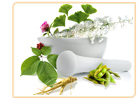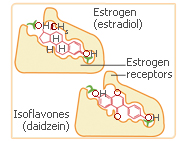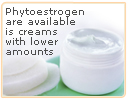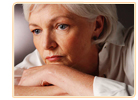Phytoestrogens
Phytoestrogen's are compounds similar in their composition to hormones in humans. Phytoestrogens appear in most plants and they have been used as treatments for centuries inadvertently. It was only in the 20th century that they were formally identified and their chemical composition analyzed.
Many plants have such small quantities of phytoestrogens that they do not effect the human body at all. Herbs however have been found to contain larger amounts of this substance and can effect the human body. Phytoestrogens do this by simulating human estrogen and persuading the body that they are estrogen molecules. In some cases can be useful for people suffering from hormone related problems. That is why herbs for menopause can be divided into herbs that contain phytoestrogen and non-estrogenic herbs.
Phytoestrogen Sources: There are several plant sources of Phytoestrogen, the most commonly found are:
Class
Isoflavones.
Flavanols.
Flavones.
Sources
Soy beans, tempeh, tofu, soy milk. Soy sauce is not a significant source of isoflavones and is high in sodium.
Onions, lettuce, tomatoes, red wine, green tea.
Apples, green tea.
keep reading to learn more about specific phytoestrogen herbs, or click the following link to read more about what is a phytoestrogen
Phytoestrogenic Herbs
There are several herbs which are good sources of phytoestrogens. Many of these herbs are currently available as herbal remedies or supplement. Phytoestrogenic herbs can help people who are suffering from hormone related ailments, as it mimics the bodies own source of the estrogen hormone. Although phytoestrogens are found in all plants they commonly only appear in large doses in herbs, too small a dose does not have any effect on the way the human body functions.
Most Common Phytoestrogenic Herbs
The most commonly phytoestrogenic herbs used are:

. Black Cohosh.
. Ginsing.
. Soy phytoestrogen.
. Red Clover Phytoestrogen.
. Dong Quai phytoestrogen.
Now that phytoestrogen herbs have been defined and their sources identified, continue reading the next section to learn more about the uses of phytoestrogenic herbs, or click the following link to read more about phytoestrogen herbs
Uses of Phytoestrogen Herbs
Phytoestrogenic herbs are useful in a number of ways for improving health and giving relief to specific aliments which affect the human body. For a better understanding of their uses, it is important to read how phytoestrogenic herbs work.
How Do Phytoestrogenic Herbs Work?
 Herbal phytoestrogens work by binding to estrogen receptors in the body and in response, their low estrogen levels help to balance the bodies own estrogen levels. If estrogen levels are to high, the phytoestrogen compounds occupy the estrogen receptors in replace of the stronger human version of the hormone. Herbal phytoestrogens work by binding to estrogen receptors in the body and in response, their low estrogen levels help to balance the bodies own estrogen levels. If estrogen levels are to high, the phytoestrogen compounds occupy the estrogen receptors in replace of the stronger human version of the hormone.
What are Phytoestrogenic Herbs Used for?
As phytoestrogens mainly affect the hormonal balance of a person it is no surprise that these herbs are currently used to treat hormonal problems such as: menopausal side effects and osteoporosis.
Both these conditions mainly effect women and as estrogen appears in larger amounts in women it makes sense that phytoestrogens are commonly used to help women.
Phytoestrogen Products
 Phytoestrogens appear in many of the foods that appear in the modern diet. This means many people are ingesting phytoestrogens without even realizing it. However this doesn't mean that more concentrated amounts of the substance aren't readily available over the counter. Phytoestrogens can be bought in tablet form and even as phytoestrogen herbal creams. Phytoestrogens appear in many of the foods that appear in the modern diet. This means many people are ingesting phytoestrogens without even realizing it. However this doesn't mean that more concentrated amounts of the substance aren't readily available over the counter. Phytoestrogens can be bought in tablet form and even as phytoestrogen herbal creams.
Keep reading the next section to learn about their benefits or click the following link to learn more about the uses of phytoestrogenic herbs.
Phytoestrogen Herb Benefits
Phytoestrogen can benefit many people suffering from hormone related aliments. By imitating the bodies own estrogen and balancing hormone levels which would otherwise be unstable.
Phytoestrogenic Herbs and Women
As women have higher levels of estrogen in their bodies naturally, it is not surprising that women can reap the benefits of phytoestrogen more than men. Phytoestrogenic herbs can benefit women in a number of ways. Menopause symptoms are currently the most popular reason women use phytoestrogens and as a result many find relief from the uncomfortable and distressing symptoms of:
. Hot Flashes.
. Mood Swings.
. Headaches.
Phytoestrogenic herbs can be beneficial for women during menopause,but it is also important to learn about their side effects in order to have a better understanding of phytoestrogens and their effects in women.
Keep reading below to learn the possible side effects which come with the use of phytoestrogenic herbs or click the following link to read more about the benefits of phytoestrogenic herbs.
Side Effects of Using Phytoestrogen Herbs
Phytoestrogenic herbs are a great treatment for menopause symptoms, and are relatively inexpensive compared to HRT. However, use of Phytoestrogenic herbs has recently been criticized, because the plants add hormones to the body artificially and thus can trigger a range of undesirable side effects, including serious problems like breast cancer.
Other hormone medication
Contraceptive pill or HRT should not be taken along side phytoestrogens. Side effects may include these treatments becoming ineffective.
Phytoestrogenic Herbs and Cancer
Research has indicated that these herbs can both accelerate growth of cancer cells and also stop their growth. While a 2001 study showed phytoestrogens in the amount commonly consumed by American women appeared to have little effect on the risk of breast cancer, to date, research on the connection between soy products and breast cancer has been inconclusive.
Read the next section where the relationship between phytoestrogenic herbs and their use during menopause is explained, or click the following link to read more about the phytoestrogens side effects
Phytoestrogenic Herbs and Menopause
 Phytoestrogens helps to calm wavering menopause symptoms during this troublesome period in a woman's life. Some doctors propose Phytoestrogenic herbs as an alternative to Hormone Replacement Therapy (HRT), because they work in very similar ways, but pose less of a risk than man-made hormones, but due to the lack of research on these herbs, doctors say that the safety of phytoestrogens cannot be guaranteed. Phytoestrogens helps to calm wavering menopause symptoms during this troublesome period in a woman's life. Some doctors propose Phytoestrogenic herbs as an alternative to Hormone Replacement Therapy (HRT), because they work in very similar ways, but pose less of a risk than man-made hormones, but due to the lack of research on these herbs, doctors say that the safety of phytoestrogens cannot be guaranteed.
For this reason it is important to seek the advice of a medical professional before starting a course of such supplements. Click this link to learn more about phytoestrogenic herbs and menopause.
Conclusions
Although phytoestrogens do have their positives and many people find them to be effective in treating hormone and estrogen related health problems, phytoestrogen supplements can also have negative side effects which come with any product which introduces foreign products into the body. To learn more about alternatives, such as non estrogenic herbs read the article below.
Which herb should women try? Today women are looking for relief from their menopause symptoms with herbs. Phytoestrogenic herbs and non-estrogenic herbs are good in relieving menopause symptoms, but recent studies show that non-estrogenic herbs have no side effects because they help the body to produce its own hormones instead of introducing hormones like the phytoestrogenic ones. Learn more about non-estrogenic herbs for menopause.
| 

